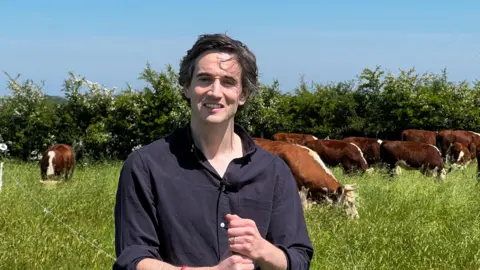The recent article titled “Can Farmers Still ‘Go Green’ Without Grants?” by Dave Harvey, a Business and Environment Correspondent for BBC West, addresses the challenges and potential solutions for farmers facing the withdrawal of government grants aimed at encouraging sustainable farming practices. The discussion is particularly pertinent as the UK government has recently cut funding for the Sustainable Farming Incentive (SFI), prompting concerns among farmers about their future viability.
Farmers are now faced with a dilemma: should they focus on maximizing food production for profit, or commit to environmentally sustainable practices at a potential financial loss? This is a significant consideration for many in the agricultural sector, especially since the Sustainable Farming Incentive provided crucial financial assistance for those growing crops that benefit nature. Amidst rising costs and climate pressures, the hope for sustainability in farming appears more challenging than ever.
However, Aidan Stanley, who operates Lilliput Farm near Bath, illustrates that a sustainable operation can still be profitable. Stanley raises beef cattle exclusively on natural grass pastures—an approach that notably reduces carbon emissions. His affirmative stance highlights a growing public demand for low-carbon beef as part of the solution to the rural economy’s shifts. Stanley emphasizes that consumer interest in sustainable farming practices is what allows his business model to thrive, even in a changing financial landscape.
On visiting Lilliput Farm, Stanley and his father Oliver reveal their traditional farming methods, which have remained largely unchanged since the English Civil War. Their cows graze on naturally occurring grass meadows, which haven’t been ploughed in centuries. Such practices are not only eco-friendly but have economic advantages as well—cattle reared in this way reportedly consume less grain and reduce reliance on heavy fertilizers and transport, thus saving on costs and ultimately producing a lower carbon footprint.
Nevertheless, the operational costs tied to this ecologically sound approach are not insignificant. The cattle raised on these traditional pastures take significantly longer to reach market weight, around three years compared to the 15-month standard for conventional cattle ranching. This longer timeframe and commitment to higher animal welfare inevitably lead to higher expenses per unit of beef produced, raising questions about how to sustain profitability in light of these compromises.
For Stanley, one answer lies in a unique business model: a farm-to-table restaurant that directly markets his beef to consumers. This business not only provides an additional revenue stream but also allows him to reinforce the values of sustainable farming. With 22,000 customers in its first year, the restaurant demonstrates both the demand for high-quality, locally sourced food and the public’s willingness to support sustainable agriculture. However, he also acknowledges the increasing difficulties faced by farmers as governmental support wavers, making it more pivotal for the public to engage with and support local producers.
While Stanley’s farm serves as a successful case study, the broader question remains about the capacity of other farmers to adopt similar green practices without such innovative outlets. By showcasing Jimmy Woodrow, who operates Pasture for Life, the article further explores alternatives available to farmers contemplating a switch to more sustainable farming. Woodrow highlights the financial benefits of raising cattle on grass rather than grain—emphasizing lower costs associated with feed and other overhead expenses, although he notes that profit margins can be tight and scaling up often requires additional governmental support.
As the UK government navigates the complexities of agricultural reform, there are ongoing consultations to replace the SFI with something more functional in supporting farmers while catering to environmental demands. During this transitional phase, establishing greener farming techniques may require more than just individual initiative; successful implementation will likely hinge on supportive frameworks that ensure both ecological sustainability and economic viability for farmers across the country. In summary, the article captures the tension between profit and sustainable practices and presents a beacon of hope through innovative business models while outlining the pressing need for continued support from government initiatives.



